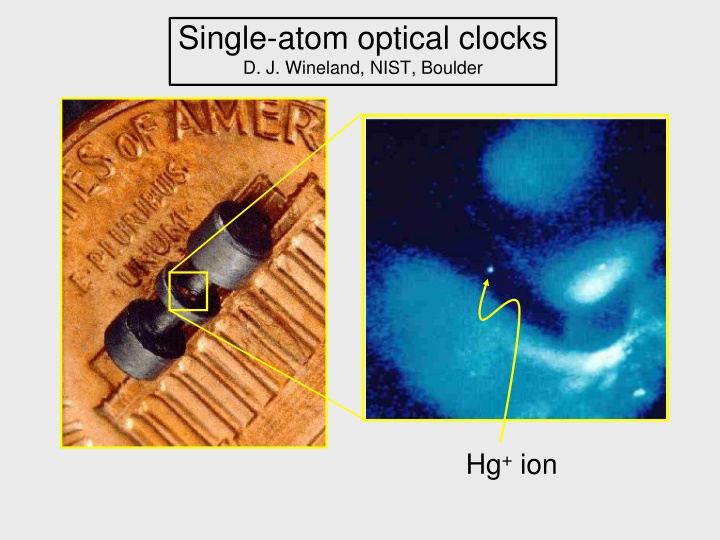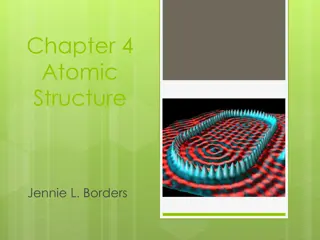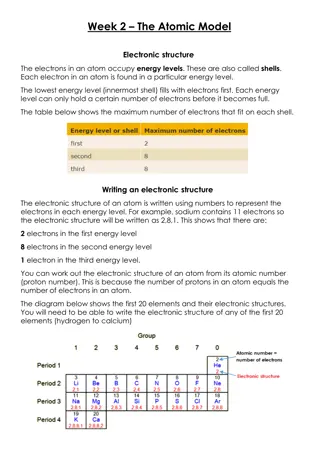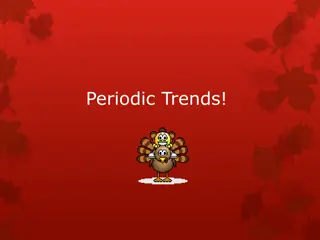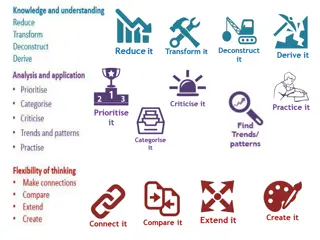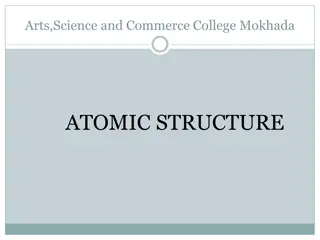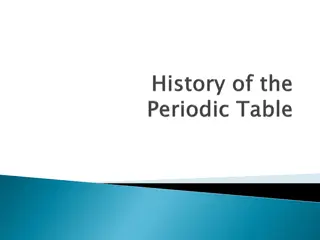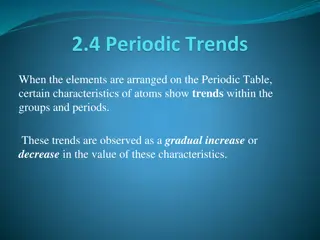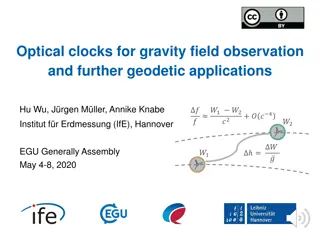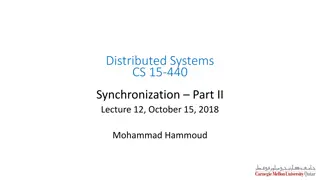The Importance of Atomic Clocks in Modern Technology
Explore the significance of precise timekeeping provided by atomic clocks, the fundamentals of atomic clocks, the advancements in single-atom optical clocks by experts like D. J. Wineland from NIST Boulder, the role of atomic energy state superpositions, and the practical operation of atomic clocks. Understand why atomic clocks are crucial for precise global navigation systems like GPS and how they outperform traditional clocks in accuracy and reliability.
Uploaded on Sep 25, 2024 | 2 Views
Download Presentation

Please find below an Image/Link to download the presentation.
The content on the website is provided AS IS for your information and personal use only. It may not be sold, licensed, or shared on other websites without obtaining consent from the author.If you encounter any issues during the download, it is possible that the publisher has removed the file from their server.
You are allowed to download the files provided on this website for personal or commercial use, subject to the condition that they are used lawfully. All files are the property of their respective owners.
The content on the website is provided AS IS for your information and personal use only. It may not be sold, licensed, or shared on other websites without obtaining consent from the author.
E N D
Presentation Transcript
Single-atom optical clocks D. J. Wineland, NIST, Boulder Hg+ ion
Single-atom optical clocks D. J. Wineland, NIST, Boulder Summary Why precise clocks? Atomic clock basics Optical atomic clocks - atomic ion examples (neutral atoms good too) Why single atoms? State of play Future Hg+ ion
Why precise clocks? Navigation: e.g. satellite navigation (GPS) pulse emitted at t0 pulse received at t1 = c x (t1 t0) error: = c t for t = 10-9 s, 30 cm ( t)/(1 day) = 10-14 f/f0
Global positioning system GPS satellite network gives 3 space dimensions + time
Clocks periodic-event generator Traditional periodic event-generators, or frequency references: pendulum clock counter
Atomic energy state superpositions act like pendulum clock |2 Energy superposition of electron energy levels, wave function: = |1 + exp(-i2 f0t) |2 oscillating electric dipole at frequency f0 = (E2 E1)/h |1 center of atom Planck s constant plot of electron density vs. time
Atomic energy state superpositions act like pendulum clock Energy |2 superposition of electron energy levels, wave function: = |1 + exp(- i2 f0t) |2 oscillating electric dipole at frequency f0 = (E2 E1)/h |1 center of atom Planck s constant plot of electron density vs. time Practical mode of operation: 1. Start atom in |1 . 2. Apply radiation at frequency fL for short time. |2 3. Measure probability of | 2 . Maximum | 1 | 2 transition probability when fL = f0 . |1
Atomic clock recipe electronic feed back servo absorption f f0 radiation source frequency f detector 2 transparent cell ( trap ) containing atoms 1 counter
Why atomic clocks? Pendulum: f = [g/ ]1/2/2 Atoms: gravitational acceleration Environmental sensitivity: (e.g. temperature T) Environmental sensitivity: (e.g. temperature T) relativistic time dilation: (f0(T) f0(T = 0))/f0 = - (v/c)2 -1.4 x 10-13 T/M(u) f/f0 = - ( T) coefficient of thermal expansion: = ( T) low expansion materials: ~ 10-8/ C For M = 133 u (e.g., 133Cs Cesium) f/f0 -1 x 10-15/ C f/f0 -5 x 10-9/ C Reproducibility: Reproducibility: f0 depends on: manufacturing tolerances ( ) all atoms of a particular kind (e.g., 133Cs ) are identical! local value of g atoms don t wear out! wear
f = 1/(2Ttransit) Atomic beam spectrometer absorption -waves f0 -wave cavity (Ramsey method) count atoms atomic beam state detection (e.g., state-dependent fluorescence) state preparation (e.g. laser optical pumping) f ~ 1/(2Ttransit) e.g., Cesium beam clock (hyperfine trans.) f0 9 192 631 770 Hz (microwaves) e.g., NBS-6 (~ 1976) L = 3.75 m, f 30 Hz (Ttransit ~ 16 ms)
f = 1/(2Ttransit) Atomic beam spectrometer absorption -waves f0 -wave cavity (Ramsey method) count atoms atomic beam state detection (e.g., state-dependent fluorescence) state preparation (e.g. laser optical pumping) Atomic fountain NIST F-1 Ttransit 1 s -waves atom cooling, state preparation & detection
Why optical atomic clocks? tick rate can be fast; e.g., for 199Hg+ ( 2S1/2 2D5/2) f0 = 1 064 721 609 899 144.94 (97) Hz absorption range very narrow e.g., for 199Hg+ , f0 1.6 Hz From 1879 text written by Thompson (Lord Kelvin) and Tate, (Idea attributed to Maxwell) ``The recent discoveries indicate to us natural standard pieces of matter such as atoms of hydrogen or sodium, ready made in infinite numbers, all absolutely alike in every physical property. The time of vibration of a sodium particle corresponding to any one of its modes of vibration is known to be absolutely independent of its position in the universe, and it will probably remain the same so long as the particle itself exists." W. F. Snyder, Lord Kelvin on atoms as fundamental natural standards (for base units) IEEE Trans. Instrum. Meas., 99, 1973.
Hg+ ion optical clock experiments at NIST(1981 ) = 0.1 s trap electrodes 2D5/2 2S1/2 282 nm 199Hg+ 1 mm
Why just one ion? (single ions smallest systematic errors) = 0.1 s trap electrodes 2D5/2 2S1/2 for two ions, 1 mm quadrupole shift ~ 1 kHz
Single Hg+ ion optical clock experiments at NIST,1981 2P1/2 trap electrodes Hg+ 2S1/2 Laser cooling 194 nm 194 nm 199Hg+ 1 mm Single Hg+ ion
Single Hg+ ion optical clock experiments at NIST,1981 = 0.1 s trap electrodes 2D5/2 2S1/2 282 nm 199Hg+ 1 mm
Detection: 2P1/2 trap electrodes 2D5/2 Hg+ 2S1/2 cooling and detection! 194 nm 1 mm
Detection: 2P1/2 trap electrodes 2D5/2 Hg+ 2S1/2 194 nm 199Hg+ 1 mm
2P1/2 trap electrodes 2D5/2 Hg+ 2S1/2 atom in 2S1/2state atom in 2D5/2state 1 mm
Ion trap in vacuum at liquid Helium temperature ( 4 K) suppresses ion loss (Tstorage ~ 6 months) suppresses heating, perturbations from collisions reduces blackbody radiation shifts imaging lens trap
2-mirror resonant cavity: laser stabilization: distance = integer number of half- wavelengths averaging time = 20 s proximity sensors = 563 nm Brendt Young, Flavio Cruz, Wayne Itano, Jim Bergquist , PRL 82, 3799 (1999) + ICOLS 99
Frequency counters, > 2000 Mode-locked laser E(t) synchronize carrier phase with pulse phase t Frequency domain I(f) fr f 0 f1 f2 feed back on laser to make fbeat 0 f2 = 2 f1 f1 = M fr ! X 2 fbeat T. H nsch, J. Hall et al.
Single 199Hg+ ions for (optical) clocks: J. C. Bergquist et al., (NIST)1981 2P1/2 2D5/2 Hg+ Jim Bergquist 2S1/2 trapping first-order Doppler shift 0 laser cooling time dilation small trapping in high vacuum at 4 K small environmental perturbations (collisions, black body shifts, etc.) first clock with systematic uncertainly (7x10-17) below Cesium - W. H. Oskay et al., Phys. Rev. Lett. 97, 020801 (2006)
Single 199Hg+ ions for (optical) clocks: J. C. Bergquist et al., (NIST)1981 2P1/2 2D5/2 Hg+ Jim Bergquist 2S1/2 Plus several other ion species: 88Sr+, 171Yb+, 27Al+, 40Ca+, 115In+ trapping first-order Doppler shift 0 laser cooling time dilation small trapping in high vacuum at 4 K environmental perturbations (collisions, black body shifts, etc.) small first clock with systematic uncertainly (7x10-17) below Cesium - W. H. Oskay et al., Phys. Rev. Lett. 97, 020801 (2006) see, e.g., A. Ludlow et al., arXiv:1407.3493 229Th3+ (PTB, UCLA Kuzmich group)
Al+quantum-logic clock (T. Rosenband, D. Lebrandt et al.) Coulomb interaction 1P1 trap at ~ 300 K 2P3/2 3P0 Till Rosenband David Leibrandt = 280 nm Al+ (F=2, mF = -2) = 167 nm 2S1/2 25Mg+ (F=3, mF = -3) 1S0 | Al + | Al motion superposition | Mg + | Mg laser-cooled Mg+ keeps Al+ cold Mg+ helps to calibrate B2 from all sources collisions observed by ions switching places P. O. Schmidt et al.,Science 309, 749 (2005)
Systematic frequency shifts Example: relativistic effects in measurement Doppler shifts: f/f0 = v /c v2 /c2 v /c: ( first-order Doppler shift) for f/f0 = 10-18 | v | = 0.3 nm/s trap vs. probe laser? Remove as in spacecraft ranging (Bob Vessot, Ed Mattison et al., PRL 45, 2081 (1980)) v2 /c2 : (time dilation shift) suppressed with laser cooling with all systematic errors, uncertainty (27Al+) = 8.0 x 10-18 gravitational-potential red shift f/f0 = grav/mc2 = glocal h/c2 2nd twin paradox after 80 years, your twin (at sea level) would be 1/1000 second younger
Some fun science: Clocks and relativity single Al+ ion clock (pre-wristwatch model)
James Chou with portable Al+ clock (clock #1) (reference clock in adjacent room, clock #2)
clock #1 raised 33 cm (~ 13 inches) f1/f2 = 1.000 000 000 000 000 041(16)
Moving target! Jun Ye s group (JILA), Sr neutral atoms in optical lattice: 2.4 f/f0(systematic) = 6.4 x 10-18 (B. J. Bloom et al., Nature 506, 71 (2014)) T 30 mK PTB, Braunschweig, Germany f/f0(systematic) = 3.3 x 10-18 (unpublished) weak (octupole) transition, laser Stark shifts, H. Katori group (Riken) Sr neutral atoms in optical lattice f/f0(systematic) = 7.2 x 10-18 (arXiv:1405.4071)
Future? * Navigation at < 1 cm scale: - Measure earth strain earthquake prediction - geodesy: map earth via gravitational red shift * Fundamental science: - are the strengths of the basic forces really constant in time? - possible deviations from Einstein s general relativity?
NIST IONS June 2014 Jim Bergquist, John Bollinger, Joe Britton, Justin Bonet, Ryan Bowler, John Gaebler, Andrew Wilson, Dave Wineland, David Leibrandt, Peter Burns, Raghu Srinivas, Shon Cook, Robert Jordens David Hume Ting Rei Tan Shlomi Kotler, Dustin Hite, Katie McCormick ,Susanna Todaro, Leif Waldner, Yiheng Lin, Daniel Slichter, James Chou, David Allcock, Didi Leibfried, Jwo-Sy Chen, Sam Brewer, Kyle McKay Not pictured: Brian Sawyer, Till Rosenband, Wayne Itano, Dave Pappas, Bob Drullinger
